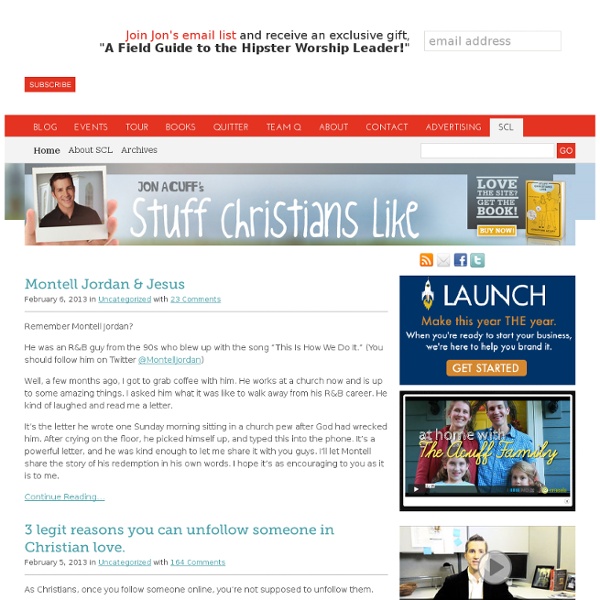



Rolling Around In My Head Dan Kimball: Vintage Faith Desiring God Blog Blog By Topic Subscribe David Mathis Wednesday went quietly. With the previous three days awash in drama — Sunday’s triumphal entry, Monday’s temple cleansing, and Tuesday’s temple controversies — now Wednesday, April 1, A.D. 33, comes like the calm before the storm. But out of sight, lurking in the shadows, evil is afoot. Marshall Segal Sometimes it’s hard to sort out our lives before Christ. In his new single “Crimson Cord,” Propaganda pulls on the scarlet thread of God’s love in the past of the believer. Justin Taylor and Andreas Köstenberger It is now Tuesday morning, March 31, A.D. 33. Now if the disciples had ears to hear they would recognize that Jesus is talking about more than seemingly magical powers that can curse trees and crumble mountains.... Jonathan Parnell To help you make the most of Holy Week, we’ve ventured into the archive to find five of the best Piper articles related to the Easter season. 1. Just... Jon Bloom Ben Stuart “How do I love my wife well?” David Crabb
What Travis Says nienie Building Healthy Churches Editor’s note: We asked Harold Best and Ken Myers the same three questions: Can God employ any musical form for redemptive purposes? Even if God can employ any musical form redemptively, are some musical forms spiritually or morally “better” than others? We'll publish Myers' answer tomorrow. My answers to these questions derive from principle, not the music I love, like, tolerate, or loathe. Can God employ any musical form for redemptive purposes? First, there are possible implications in the question that need clarification. (1) The question seems to imply that some forms might be more useful to God than others based on assumed aesthetic or moral qualities. (2) The question seems to imply that God might have to work harder with music x than music y because x is unfamiliar, overly complex, or overly simplistic, while y meets all “relevance” criteria. The template is clear: God saves people, and uses created things in whatever way he pleases. There are important principles at work here.
Julie Roys 60 Must-Read Health & Fitness Blogs for 2012 There's a dizzying number of blogs out there, all tempting us to procrastinate at work. But it's hard to know which sites are truly trustworthy, entertaining, informative, and Pinnable. So we went ahead and scoured the blogosphere to narrow it down to these standouts. They're keeping it real (no #fitspo here), using science to back up claims, always staying positive and inspiring, and delivering content we can't stop reading and sharing. We went after blogs that address interesting and timely issues and feature useful, upbeat (but never in an annoying way) posts that reflect Greatist's mission of making healthy living a little bit easier and a lot more fun. Note: Blogs are arranged in no particular order.
Pondered In My Heart Ash Wednesday is one week away! It's almost time to begin. Are you prepared for Lent? Those of us who attend the Extraordinary Form of the Mass following the traditional 1962 Church calendar have the benefit of a pre-Lenten season called Septuagesima. As Pius Parsch puts it in The Church's Year of Grace, "To effect a transition from the joyous spirit of Christmas time to the sober and serious character of Lent, the Church has inserted a period of mental conditioning before Ash Wednesday." Just as our church looks different with violet vestments, and the Mass is different with joyous exclamations omitted, so our homes, our domestic churches, should look and feel and perhaps even sound different during the season of Lent. Of course there are the additional private sacrifices, the practices that can remain hidden from even those closest to us. Sometimes it seems like modern folks eschew the 'giving something up' for Lent, regarding it as juvenile or old-fashioned. Download Lent 2014
John Maxwell on Leadership Tomorrow is Thanksgiving in the United States, and I know I’m looking forward to a wonderful day of food and family. I hope your plans for the holiday will be meaningful and fun. I don’t know about you, but the Thanksgiving holiday always gets me thinking about gratitude.... Read more Every fall, I have the distinct privilege of participating in two world-class events. What do you do after training leaders in every nation? What drives you when you get up in the morning? Last week I talked to you about rewriting your story into one of significance. What’s your story? No matter what your goals are, communicating with others in a meaningful way can help you. There's a secret to filling the pages of your life. Most teams don’t naturally get better on their own. Leadership Blind Spots Do you have any blind spots?
Persecution Blog